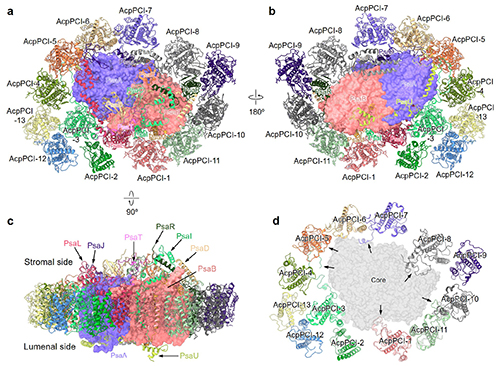The team led by Prof. Zhang Yuzhong from OUC’s College of Marine Life Science, Key Laboratory of Evolution and Marine Biodiversity, and Frontiers Science Center for Deep Ocean Multispheres and Earth System, published an article titled “Architecture of symbiotic dinoflagellate photosystem I-light-harvesting supercomplex in Symbiodinium” in Nature Communications, in collaboration with Prof. Gao Jun from Huazhong Agricultural University.
With single-particle cryo-electron microscopy, this research investigates the high-resolution structure of PSI-LHCI and its structural features. The core of PSI consists of 13 subunits including two newly identified subunits, PsaT and PsaU, and the periphery of the core binds 13 trapping units containing chlorophyll a/c (Chl a/c) and light-harvesting complexes (AcpPCI) of peridinin. Compared with other PSIs of red algal evolutionary clade, the core subunit PsaD/E/I/J/L/M/R and terminal structures of the light-harvesting complex AcpPCI-1/3/5/7/8/11 subunits have extended and interact with the surrounding subunits. The core subunits PsaA and PsaB are structurally conserved, but in PSI-AcpPCI, the superficial loop structure changes significantly which also interacts with the extended structure of special subunit. These special structures strengthen the connection among central subunits, promote the stability of the complex PSI–AcpPCI and help PSI-AcpPC adapt to the particular symbiotic environment.
PSI-AcpPC has a unique pigment network. The structural change in its core subunits PsaA and PsaB leads to the deficiency and addition of pigments. Computational calculation of energy transfer finds that the unique way of energy transfer in PSI–AcpPCI can effectively deliver and quench the energy. This research provides a solid structural foundation for revealing the light-harvesting and energy transfer mechanisms of the symbiodinium PSI-LHCI adapting to the symbiotic ecosystem and the basis for a deeper understanding of the evolutionary diversity of PSI-LHCI in photosynthetic organisms.
Prof. Zhang Yuzhong’s team has long been engaged in the study of algal photosynthesis. Recent research outcomes of algal photosynthesis have been published in Nature Plants (Nat Plants, 2020, 6: 869), The Plant Cell (Plant Cell, 2023, 35: 2449), and Plant Physiology (Plant Physiol, 2022, 190: 1883). The publication in Nature Communications marks an important progress.

